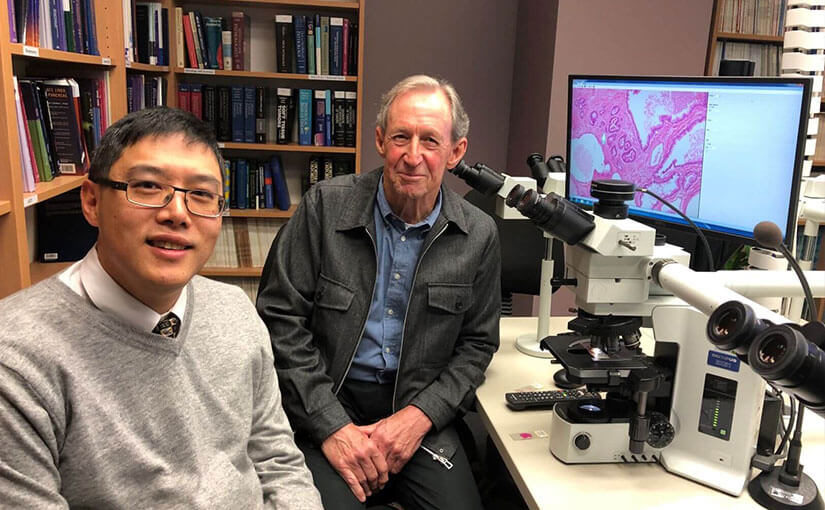Image: Prostate cancer survivor Vincent Jenkins (R) has a rare chance to meet anatomical pathologist Dr Peter Nguyen (L) who made his life changing diagnosis
Unlike most patients who have been through cancer treatment, Vincent Jenkins has seen inside the laboratory where his diagnosis happened.
At the Melbourne Pathology laboratory that diagnosed his prostate cancer, Vin was able to get a close look at his own prostate biopsy slides and meet with Dr Peter Nguyen, the pathologist whose diagnosis led to life-changing surgery.
Eleven years ago, Vin went to his GP for an annual check-up, and was recommended to have a PSA blood test and have his prostate checked.
Prostate cancer is the most commonly diagnosed cancer in Australian men, and 100% of all cancers are diagnosed in pathology labs.
After surgery to remove his prostate, Vin has been in remission for 11 years. A keen golfer, he now lives an active lifestyle after his most recent brush with cancer.
Inside the lab Vin was able to learn how a biopsy examined by Dr Nguyen saved his life – and to meet Dr Nguyen for the very first time.
“This first test indicated that things were not normal, and I was told to come back in 6 months to see how things had progressed. It was then that we found that the situation had deteriorated.”
“I had never thought about having prostate cancer or even having a test,” said Vin, “that’s the scary thing – I had no symptoms whatsoever. I was asymptomatic, which is why I was so surprised to get back such high PSA test results.”
“After that my urologist suggested I have biopsies to check out my prostate. I was then diagnosed with prostate cancer and I was booked in for surgery about four weeks later,” said Vin, who retired from a career in marketing and advertising some years ago.
Anatomical pathologists like Dr Nguyen are the doctors who examine body tissue samples, such as Vin’s prostate biopsy, to diagnose disease and advise the medical team about treatment, as well as giving the all clear after successful surgery or therapy. Australia’s pathology sector boasts some of the highest quality standards in the world.
“The pathology is interesting to me, because after my prostate was removed, I was concerned that the cancer wasn’t confined to the prostate. However, the pathology tests confirmed that it was, which was a huge relief,” said Vin.
The 5-year survival rate for prostate cancer is 95%, however if cancer spreads to other parts of the body it is harder to treat.
Prostate Cancer Foundation of Australia CEO, Professor Jeff Dunn AO said:
“Regular health check-ups help with early detection, which is crucial in effectively fighting prostate cancer. Men over the age of 50 – or 40 if they have a family history of prostate cancer – need to talk with their GP about prostate health. If you fit the criteria, speak to your GP and remind your loved ones and friends to as well.”
Each year in Australia, approximately 20,000 men are diagnosed with prostate cancer and around 3,500 die of the disease, meaning early diagnosis is crucial to save lives.
“That’s why we need to encourage men over 50 to have regular tests done. If you don’t have symptoms, you can still have cancer. And the most important thing is to catch it early, like I did,” said Vin.

